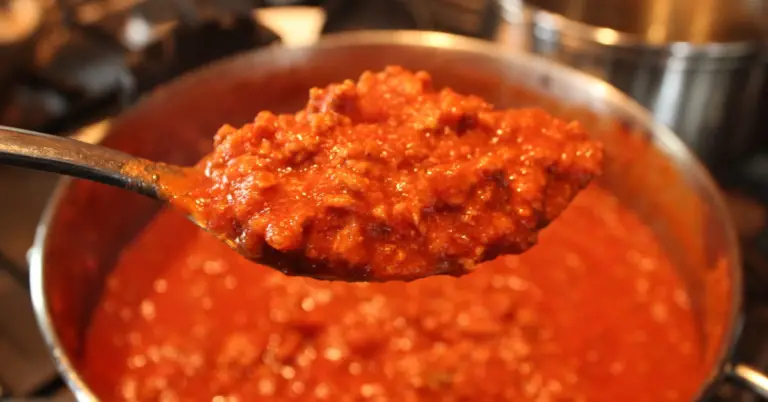Welcome to another episode of “It looks Italian, but it is not”. Some recipes seem to come from our boot-shaped peninsula but, on the contrary, have only a few words of Italian in the name and, maybe, distant origins “scrambled” by the generational succession, as the case of the Milanesa Napolitana.
Indeed, the Milanesa Napolitana is a dish that cannot be found in Italy and which actually comes from Argentina; even though, on a closer investigation, it is possible to find some of our Italian “responsibility” in its birth and diffusion. And not even that inspiring.
See which Italian-American delicacies are unknown in Italy – click to explore!
If your next question is: “Ok, but why isn’t such a good dish with (fake) Italian origins cooked and appreciated in Italy today?”
Let me explain why this dish does not catch on in Italy, here are the specific reasons:
- In general, the average Italian does not like “toppings” on his plate, having a delightful breaded and crunchy cutlet prepared, and then seeing it covered with tomato sauce and mozzarella is not exactly our ideal dish.
- The Italian dish that comes closest to the Milanesa Napolitana is precisely the Milanese cutlet but, if you go to any Milanese restaurant and ask for a cutlet with tomato sauce, ham and mozzarella on top, you will probably be led out of the place, Milanese people are very proud of their own flagship dish and do not digest profane variants.
- Every Milanese knows it, for a textbook Milanese cutlet a slice of veal loin is used (generally with the bone), in the Milanesa Napolitana beef is used, a poetic license too serious for Italians.
- The very name of this dish hides an intrinsic contradiction to the recipe, Milan and Naples, two Italian cities at the antipodes, by geographical position, by food culture and therefore recipes! Italian recipes are all regional and hardly mix the cultures of two different regions. Mozzarella is a typical food of the South, the cutlet of the North.
As you can see, each of these reasons does not take into consideration the taste of Milanesa Napolitana, personally I have never tasted this dish in my life but, if I had the chance, I would gladly do it, because I think I could really like it.
This is to say that the reason why this dish does not catch on in Italy has nothing to do with its actual goodness, but it is more a reason for tradition and food culture, two aspects that have sculpted Italian cuisine over the years we know today.
Milanesa Napolitana is not a traditional Italian dish, in addition the mixture of tastes and ingredients is in sharp contrast to our regional food culture, despite being invented by an Italian…or maybe not!
Milanese Napolitana: dish born in Argentina from a careless Italian (?)
Ironically, in the name of this dish there are references to two important cities of our country, Milan (Milanesa), symbol of the North Italy and Naples (Napolitana), symbol of the South. Yet, the story of this recipe comes from all other hands, at least according to popular stories.
Buenos Aires, 1940s. In the El Napolitano restaurant, a customer orders a Milanesa, that is a Milanese cutlet, a typical dish, yes it is true, of the Lombard tradition made with veal cutlets, flour, breadcrumbs, eggs, butter, pepper and salt. Evidently, the kitchen pantry must not have been very well-stocked – or, despite the sign, the staff had very little to do with Italian culinary customs – so that it ended up on the plate with some beef, fried in oil instead of butter.
All (more or less) regular until the cook, careless as few others, realized that he had scorched one of the two sides of the meat; how to solve this?
According to one version of the story, the time was particularly late and that was the only slice of beef left in the pantry. Thus, the careless-but-clever chef organized himself to confuse the waters: he scratched the blackened part and, in order to cover it, he used tomato, ham and cheese, cooking everything in the oven for a few minutes
The idea would have come from thinking of the recipe for Valle d’Aosta cutlet, similar to the Milanese one but prepared, indeed, with a breading inside which there is also a slice of ham and stringy cheese.
Unexpectedly, the result was such a great success that it turned that mistake into the typical dish of the restaurant.
Another version of the story would have the restaurant called “Napoli” by the owner and cook, José Napoli. Although someone spoke about a certain Jorge La Grotta. A different line intertwines the whole story with the fact that the restaurant would have been opened by Italian immigrants in Argentina and there are even those who have hypothesized that the dish was, actually, created by an assistant, left alone to try to satisfy that troublesome customer at that hour.
No matter the truth is, a historian has tried to clarify: according to Daniel Balmaceda, author of “La comida en la historia argentina”, this restaurant would never have existed and the Milanesa Napolitana would have been born simply with the purpose to merge the traditions of the two Italian cities, probably from someone who desired to continue savoring the scents of their now distant land. In short, we are talking about a dish that, in all respects, would be Argentinian.
The Milanesa alla Napolitana today
The modern Milanesa Napolitana is the queen of Argentine table and it is often offered with a crunchy side dish of fries and a mozzarella-based dressing. Many Argentines prefer accompanying it with bread or even in a sandwich, where the meat becomes a filling. You can also find it in the menus as “Milanesa a la Napolitana”, “Milanese alla Napoli” or “Milanesa e Napolitana”. The concept is always the same.
In its most classic proposal, on the plate, there are those who see a reference to Pizza Margherita with that tomato sauce and stringy mozzarella… and so we come back to Naples again, Milan and everything that a simple recipe like this one, is able to evoke in those people who love our country, even though here in Italy (as I explained previously) nobody knows it.







